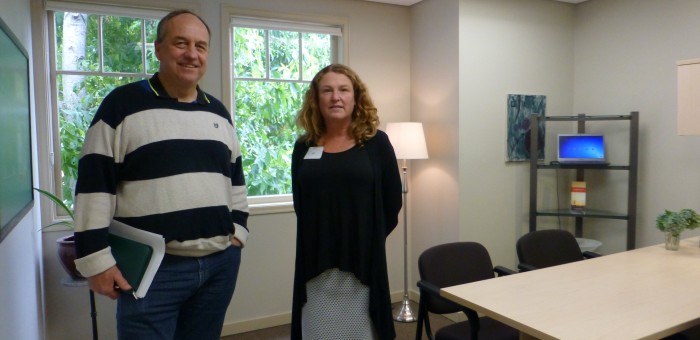Health
InspireHealth Inspires
 Last Spring I began receiving letters from some of my constituents expressing their deep gratitude for an organization called InspireHealth. I had never heard of InspireHealth, but based on the personal experiences that these constituents shared I could tell that the people and programs offered there had had a deep impact on their lives. Intrigued and wanting to learn more, we got in touch with the Victoria Inspire Health office, located right here in Oak Bay, and arranged for a meeting with Dr. Mimi Weldon.
Last Spring I began receiving letters from some of my constituents expressing their deep gratitude for an organization called InspireHealth. I had never heard of InspireHealth, but based on the personal experiences that these constituents shared I could tell that the people and programs offered there had had a deep impact on their lives. Intrigued and wanting to learn more, we got in touch with the Victoria Inspire Health office, located right here in Oak Bay, and arranged for a meeting with Dr. Mimi Weldon.
 Co-Founded in 1997 by two Vancouver-area doctors, Dr. Roger Rogers and Dr. Hal Gunn, InspireHealth is a not-for-profit health organization that provides free of charge, supportive clinical services to cancer patients and survivors throughout all of British Columbia. Made up of a team of doctors, nutritionists, exercise therapists, clinical counsellors and administrative staff, they provide individuals with guidance on a variety of health-related issues including diet changes, stress reduction and emotional counseling, decision making, exercise, immune system support and personal coaching. Members receive one-on-one consultations with their health professionals to support their health, answer their questions and provide them with the information they need to make decisions about their health; they are able to choose from an extensive selection of programs and services, including their signature LIFE Program; and they can attend a variety of classes which provide ongoing support and knowledge for improving their health.
Co-Founded in 1997 by two Vancouver-area doctors, Dr. Roger Rogers and Dr. Hal Gunn, InspireHealth is a not-for-profit health organization that provides free of charge, supportive clinical services to cancer patients and survivors throughout all of British Columbia. Made up of a team of doctors, nutritionists, exercise therapists, clinical counsellors and administrative staff, they provide individuals with guidance on a variety of health-related issues including diet changes, stress reduction and emotional counseling, decision making, exercise, immune system support and personal coaching. Members receive one-on-one consultations with their health professionals to support their health, answer their questions and provide them with the information they need to make decisions about their health; they are able to choose from an extensive selection of programs and services, including their signature LIFE Program; and they can attend a variety of classes which provide ongoing support and knowledge for improving their health.
 InspireHealth is supported in part by the B.C. Ministry of Health, who’s annual funding covers close to two-thirds of their operational costs, and in part by private and corporate donations and grants. Currently, there are three InspireHealth locations throughout B.C, as well as an online Virtual Centre for those living in remote and rural communities. The centre here in Victoria opened its doors in October of 2011 and serves Vancouver Island and the Gulf Islands with their innovative cancer care programs and services.
InspireHealth is supported in part by the B.C. Ministry of Health, who’s annual funding covers close to two-thirds of their operational costs, and in part by private and corporate donations and grants. Currently, there are three InspireHealth locations throughout B.C, as well as an online Virtual Centre for those living in remote and rural communities. The centre here in Victoria opened its doors in October of 2011 and serves Vancouver Island and the Gulf Islands with their innovative cancer care programs and services.
 InspireHealth takes a non-pharmacological approach, with a focus on lifestyle factors and self-responsibility, offering cancer patients an opportunity to have a look at the ‘big picture’ of their health. Through this supportive approach patients work with their team of medical professionals as partners in their treatment, empowering them to create their own individualized plan that improves their overall health and well-being. Patients can engage with these services before, during and after their standard cancer treatments.
InspireHealth takes a non-pharmacological approach, with a focus on lifestyle factors and self-responsibility, offering cancer patients an opportunity to have a look at the ‘big picture’ of their health. Through this supportive approach patients work with their team of medical professionals as partners in their treatment, empowering them to create their own individualized plan that improves their overall health and well-being. Patients can engage with these services before, during and after their standard cancer treatments.
While InspireHealth’s model certainly sounds impressive on paper, what was even more awe-inspiring was seeing it in action. Following our meeting with Dr. Weldon, she invited us to visit the Victoria InspireHealth Centre and witness first-hand what it is they do.
 Upon arrival, I was struck by how the bright, warm office, situated along Oak Bay Avenue, felt more like being in a friend’s home than a health care centre. Before beginning our tour of the site, we were invited to join the end of an interactive workshop that was taking place with a small group of patients. Led by Dr. Weldon and Clinical Counsellor Genevieve Stonebridge, we were told that the topic of the workshop that morning was passion.
Upon arrival, I was struck by how the bright, warm office, situated along Oak Bay Avenue, felt more like being in a friend’s home than a health care centre. Before beginning our tour of the site, we were invited to join the end of an interactive workshop that was taking place with a small group of patients. Led by Dr. Weldon and Clinical Counsellor Genevieve Stonebridge, we were told that the topic of the workshop that morning was passion.
 The participating members shared with us the profound impact InspireHealth has had on both their recovery and their lives as a whole. By creating an environment which encompasses all aspects of their health, from the physical to the mental to the spiritual, by encouraging and empowering them to be the decision-makers in their own journeys of recovery, and by providing the resources and space necessary for their loved ones to both support these journeys and receive support themselves, InspireHealth has truly changed the lives of these individuals forever. At the end of the group workshop, Genevieve asked us all to give one word to describe how we were feeling right in that moment. As we went around the room, the word that immediately came to mind seemed an obvious choice – Inspired.
The participating members shared with us the profound impact InspireHealth has had on both their recovery and their lives as a whole. By creating an environment which encompasses all aspects of their health, from the physical to the mental to the spiritual, by encouraging and empowering them to be the decision-makers in their own journeys of recovery, and by providing the resources and space necessary for their loved ones to both support these journeys and receive support themselves, InspireHealth has truly changed the lives of these individuals forever. At the end of the group workshop, Genevieve asked us all to give one word to describe how we were feeling right in that moment. As we went around the room, the word that immediately came to mind seemed an obvious choice – Inspired.
Workshop: Creating Dementia-Friendly Communities
We are pleased to welcome the Alzheimer Society of B.C. to deliver a free community workshop on October 2nd on how we can be part of creating a more dementia-friendly community.
The workshop, to be given by Rebecca Morris, Alzheimer Society of B.C. Advocacy Analyst, will focus on how to best support people living with dementia in our community. It will cover topics such as:
- understanding the signs and symptoms
- addressing misconceptions
- practical communication tips
- essential information on wandering behaviour
The workshop will give you new ideas and skills for when you are communicating with people living with dementia in your community. We can all play a role in making our community a great place to live for people with dementia!
We invite all interested community members to attend this free workshop and join us in our ongoing efforts to create communities which are friendlier to those living with dementia.
**Please note, space for the workshop is limited to 30 seats and everyone interested in attending must RSVP by email, to andrew.weaver.mla@leg.bc.ca, or by phone, to (250) 472-8528**
Event Details:
Date: Friday, October 2nd
Time: 2:00pm – 3:30pm
Location: Berwick House, 4062 Shelbourne Street, Victoria, BC
Please RSVP to: Andrew.Weaver.MLA@leg.bc.ca or (250)472-8528
If you are a caregiver or person living with dementia looking for information or assistance please call the Alzheimer Society of B.C.’s First Link Dementia Helpline at 1-800-616-8816.
The Need for Government Leadership
This is the final installment of a seven week series examining the topic of child and youth mental health in B.C. As this is a complex and multifaceted topic, I will be narrowing my focus to a few popular beliefs and areas of concern that I have witnessed in my role as MLA. The purpose of this series is to debunk these beliefs, increase awareness of these concerns, end the stigma of mental health in our society and provide opportunities for you to impact what is happening in your community.
“Considering that the well-being of our most vulnerable children and youth is at stake, I expect more from government and I think most British Columbians do as well” – Mary Ellen Turpel-Lafond, Representative for Children and Youth
Popular Belief Eight: The government is addressing the issue
Reality: While some progress has been made to promote and address issues relating to mental health, British Columbia has a long way to go. If we are to truly improve our child and youth mental health profile here in B.C. we need strong government leadership to guide us there. Something we are lacking in this province today.
A decade ago B.C. and the Ministry of Children and Family Development (MCFD) were seen as a Canadian leader in child and youth mental health services. This was thanks in large part to the 2003 Child and Youth Mental Health Plan – the first of its kind in Canada – which included strategies focused on providing treatment and support, reducing risk, building community capacity and improving performance. Even though the plan did not deliver as significantly as was hoped in all areas, a 2008 internal evaluation did find notable progress had been made in the area of preventative measures.
While the five-year plan arguably needed some tweaking, it was certainly a step in the right direction. Despite this, the plan was replaced in 2010 with the government’s new ten-year plan to address mental health and substance use in British Columbia, entitled Healthy Minds, Healthy People.
Though this new plan does respond to some of the concerns that have been raised around child and youth mental health services in B.C., it falls short of improving upon the 2003 plan. Not only is it not specific to children and youth – instead taking a lifespan approach with strategies for supporting children, youth, adults and seniors – it also does not contain any operational details of how the plan might be implemented. Nor does it specifically address any of the shortfalls found by the internal review of the 2003 plan. Thus leaving B.C. without a clear and measurable guide for providing substantive support to youth and their families.
Representative for Children and Youth
In 2006, B.C. appointed Mary Ellen Turpel-Lafond as its first Representative for Children and Youth. The Representative is an independent expert oversight body tasked with supporting children, youth and families who need help in dealing with the child-serving system.
Between the years of 2008 and 2013 the Representative’s office made a total of 148 recommendations to the provincial government to improve the lives of B.C’s most vulnerable children. While 72% of these recommendations have been acted upon, a number of the most important ones remain unfulfilled – including her recommendation for government to create a Minister of State of Youth Mental Health.
During this same five-year time period, MCFD’s budget was reduced by more than $37 million – this amounts to nearly $100 million when inflation is accounted for. While the current state of our mental health system is not solely a budget-shortage problem, it certainly plays a role. As the report points out “it is difficult to improve services on a shrinking budget.”
Furthermore, the fact that MCFD’s budget has shrunk despite the mounting evidence that our youth mental health system is in serious need of a redesign, shows just how misguided our approach thus far has been.
Where do we go from here?
Instead of cutting MCFD’s funding, we should be investing more in a Ministry that is mandated with providing crucial services to one of our most vulnerable populations.
Instead of disregarding key recommendations made by an office dedicated to protecting children and youth in B.C., we should be working with the Representative for Children and Youth to ensure our mental health system is providing current, best-practice services for all levels of care.
We need to understand that by investing in these services now, we lessen the need for more acute and expensive services in the future. And that by supporting the mental health of our children today, we are giving them the tools they need to support themselves tomorrow.
It is time for the B.C. government to recommit to the mental health and well-being of our young people and to once again become a leader in child and youth mental health services.
Weekly Action Item
I have always said that if you don’t like the way your government is addressing an issue – or not addressing one – then you need to get involved, you need to express your concerns and make your voice heard. In fact, that is precisely why I ran for office in the first place.
So this week, for our final action item, I am asking you to vote. I strongly believe that one of the most powerful tools we have at our disposal is our power to vote. With the Federal Election just around the corner and the next Provincial Election less than two years away now is the time to let your politicians know that issues surrounding Mental Health and Mental Illness are of top priority to you as a voter.
When you are contacted by campaigners, ask what their party is doing to address these concerns. Research your local candidates to find out their policies around child and youth mental health. Encourage your friends and relatives to do the same. And most importantly, when election day arrives get out and vote.
Cost-Savings of Investing in Mental Health
This is the sixth in a seven week series examining the topic of child and youth mental health in B.C. As this is a complex and multifaceted topic, I will be narrowing my focus to a few popular beliefs and areas of concern that I have witnessed in my role as MLA. The purpose of this series is to debunk these beliefs, increase awareness of these concerns, end the stigma of mental health in our society and provide opportunities for you to impact what is happening in your community.
“The cost of not mending our services to provide adequate support to vulnerable children is huge. The human cost of suffering and despair is immeasurable. The economic costs of preventable long-term use of public services, unfulfilled human resources and drain on productivity are very clear. There are many more reasons to act than not.” – Mary Ellen Turpel-Lafond, Representative for Children and Youth
Popular Belief Seven: We can’t afford to put more money into the mental health care system
Reality: Mental health problems not only have devastating emotional, physical and social impacts on individuals and their families, they can also place an enormous burden on our economy. Conservative estimates find the direct costs (ie: health care, certain social services and income support) of mental health problems and illnesses to Canada to be at least $50 billion per year – with the total cost to the economy adding up to more than $2.5 trillion over the next 30 years.
However, the true economic cost is likely much higher as current estimates exclude expenses such as costs of caregiving and costs to the judicial system. In fact, if estimates in Ireland and Wales hold true for Canada, the current cost of mental illness is approximately $192 billion dollars.
In addition to these direct costs, there are also high indirect costs of mental illness. It is estimated that approximately 21.4% of the working population experienced a mental illness in 2011, resulting in the annual productivity impact of mental illness in the workplace to be over $6.4 billion. Similarly, a report out of the United States estimated the total lifetime economic cost of childhood mental health problems and illnesses to be $2.1 trillion. When translated to our smaller population, the cost in Canada would be roughly $200 billion.
And these expenses are not just felt by the public sector. With mental health problems and illnesses accounting for 79% of long-term disability claims and 75% of short-term disability claims, the costs for disability due to mental illness are the fastest-growing disability costs for Canadian employers. It is estimated that the private sector spends between $180 and $300 billion on short-term disability claims and $135 billion on long-term disability claims due to mental illness. With evidence suggesting that mental illness will be the leading cause of disability in high-income countries by 2030.
At this rate, the total cost of mental illness to society could soon be greater than the entire cost of the health care system in Canada.
Cost-savings of addressing the issue
While the economic costs of mental illness are evident, the savings that can be gleaned from improving services and supporting upstream initiatives can be harder to prove. For one, the benefits of reducing the rates of mental health problems are often not seen until the longer term. Because of this, the costs of mental health promotion and prevention are much easier to evaluate than the benefits. Similarly, cost-savings are not necessarily seen where the money was invested. For example, savings from investing in mental health education in schools are more likely to be seen down-the-line with reduced costs to the judicial and health care systems. As a result, it is hard to put an exact number on just how beneficial such programs can be.
That being said, there is a fair amount of evidence to show that the promotion of mental health and prevention of mental illness can go a long way in combating the rising costs of mental health problems and illnesses. A recent study by the Canadian Institute for Health Information suggests that there is a return on investment (ROI) for some mental health promotion and mental illness prevention interventions. The strongest ROI evidence can be seen for children and adolescents, where promotion and prevention programs have shown to provide huge and long-term impacts.
Although more detailed research and evidence within Canada is lacking, countries such as the U.K., U.S. and Australia have produced extensive economic evaluations of childhood and youth interventions. One study found cost-savings from $1.80 to $17.07 for every dollar spent on programming. While more research is needed to understand exactly how cost-beneficial such programs can be, it is clear that by investing in mental health we benefit both the economy, and society as a whole.
Weekly Action Item
As an MLA, I have witnessed first-hand the impact that public opinion and engagement can have on encouraging the BC government to focus on a specific issue. With this in mind, please consider taking time this week to communicate to decision-makers the importance of making child and youth mental health a priority. A good place to start might be to contact your local MLA and let them know that you would like British Columbia to take more action to address the mental health needs of our youth. Perhaps starting with the recommendations made to government by the Representative for Children and Youth.
Please also consider urging your friends and family to write letters or emails to local Mayors, Councilors, MLAs and MPs, and the offices of the Premier and the Prime Minister. It is time for us to take long-lasting, substantive steps to ensure the necessary supports and resources are in place to support the mental health and well-being of our young people.
Promotion, Prevention and Early Intervention
This is the fifth in a seven week series that will examine the topic of child and youth mental health in B.C. As this is a complex and multifaceted topic, I will be narrowing my focus to a few popular beliefs and areas of concern that I have witnessed in my role as MLA. The purpose of this series is to debunk these beliefs, increase awareness of these concerns, end the stigma of mental health in our society and provide opportunities for you to impact what is happening in your community.
“A growing body of international evidence demonstrates that promotion, prevention, and early intervention initiatives show positive returns on investment.”
Popular Belief Six: The current emphasis on illness treatment is the way to go
Reality: As is common across most of the world, the current mental health system in B.C. allocates the majority of its budget and resources towards downstream, or reactive, approaches to mental health care such as illness treatment and acute services. While these services are important for helping those already struggling with mental health problems, they do not necessarily promote mental well-being or help to combat the shockingly high rates of youth mental illness throughout the province.
If we want to foster the mental well-being of our young people and reduce the number of youth experiencing mental health challenges, or at the very least identify and address these potential challenges before they get worse, we need to shift our focus from primarily ‘downstream’ approaches, to more ‘upstream’, or proactive, approaches – namely mental health promotion, prevention and early intervention.
Upstream approaches to mental health care not only help individuals identify the early stages of potential mental health challenges, thus lessening the dependency on reactive approaches and taking the strain off our current, over-worked, health care system. But they can also help to reduce the stigma associated with mental health challenges; something that can often deter youth from seeking the support that they need.
Promotion, Prevention and Early Intervention
One of the key facets of effective mental health promotion and prevention is education. However, one of the overwhelming themes identified across all demographics is the general lack of education and public awareness around mental health; particularly among young people. Not only are many adults and young people unaware of available mental health resources and supports, they are also unaware of how to identify or address the early signs of mental illness. While school curricula incorporates units on physical and sexual health, there is often little to no mental health education provided in schools.
This lack of education also plays a strong role in the stigmatization of mental health issues. Many youth experiencing mental health problems feel shame and embarrassment over their illness and admit to not accessing services because of fear of stigmatization. This fear is not hard to understand when statistics show that 42% of Canadians are unsure whether they would socialize with a friend who has a mental illness and 27% say they would be fearful of being around someone who suffers from serious mental illness.
Stigma can also prove intergenerational, as parents and caregivers may not want to admit or accept that their child, or even they themselves, has an issue. In fact, studies have found that 46% of Canadians think people use the term mental illness as an excuse for bad behaviour and only 50% of Canadians would tell friends or co-workers that they have a family member with a mental illness, compared to 72% who would discuss a diagnosis of cancer.
Similarly to mental health promotion and prevention, early identification and intervention play an important role in the ability of youth to overcome mental health challenges. Often, signs of mental ill-health in youth are not identified or acted upon early on. When such challenges are left untreated, or symptoms are ignored, they can escalate into more serious conditions in adolescence and adulthood making them harder to treat in the long term.
Mental health promotion, prevention and early intervention not only helps to build awareness and understanding around the topic of mental health and decrease the stigma associated with mental health issues, but research shows that investing more resources into these upstream approaches offers some of the greatest return on investment – especially when looking at children and youth programs.
Weekly Action Item
This week please consider combining aspects of the previous four action items and to use this knowledge and these advocacy skills to encourage the adoption of mental health promotion and prevention strategies in your local schools, your workplace and throughout your community. This can be done in a number of ways, below are just a few suggestions. If you have more, please share your ideas with us in the comment section.
- You may wish to find a local organization that especially resonates with you and that is already engaging in this type of work to find out how you can help their endeavors – volunteer, donate, fundraise, etc…
- You may want to get in touch with your child’s school to ask what initiatives or steps they are taking to improve mental health promotion and education in their school and ask how you can get involved.
- Or you may decide to promote mental well-being in your own workplace (check out the Not Myself Today campaign which is dedicated to reducing stigma and supporting mental health at work).






